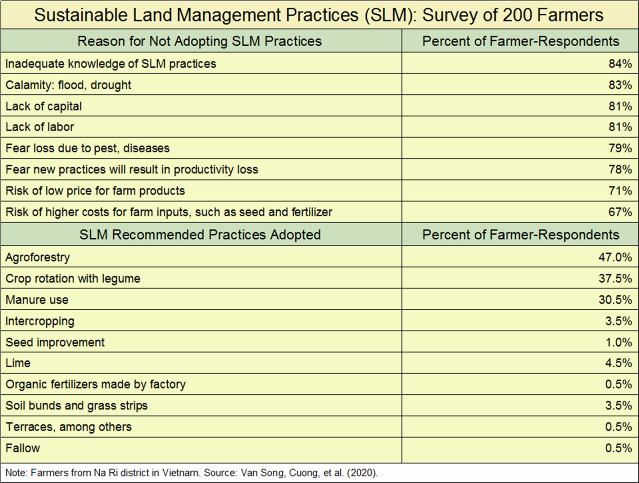“Sustainable land management comprises measures and practices adapted to biophysical and socio-economic conditions aimed at the protection, conservation and sustainable use of resources (soil, water and biodiversity) and the restoration of degraded natural resources and their ecosystem functions.” - Food and Agriculture Organization f the United Nations (FAO)
Sustainable farming includes practices to:
prevent land conversion and protect vulnerable lands;
prevent and mitigate land degradation and restore degraded soils;
control soil erosion;
improve soil-water storage;
manage soil organic matter for soil carbon sequestration;
manage and enhance soil fertility.
Unfortunately, farmers often resist new ways of doing things, especially poor farmers in developing countries. Who could blame them? Farming is full of risk and uncertainty, between the weather, pests, volatile markets, bad policies, lack of storage facilities, and inadequate infrastructure. Sustainable farming requires an investment of time, labor and capital, and the return on this investment may take years. Small farmers in particular may not have the luxury to think past the current harvest.
Here are some reasons one group of farmers gave for not adopting SLM practices, as well as their rate of adoption for each recommended practice*:
Note that the rate of adoption was respectable for agroforestry, crop rotation with legume, and use of manure. That’s because these were already well-known ways to farm in that part of Vietnam. However, almost all the farmers maintained they would not adopt an unfamiliar practice. As the authors of this study explain:
“Adoption of SLM practices may involve uncertainty and risks. For instance, applying crop rotation with legume may lead to pest and diseases, use of manure could improve the soil condition but could take a long time, while setting a soil bund and terracing would entail high labor and cost. “
Farmers with larger crops were more likely to adopt SLM practices due to their greater ability to access capital to purchase inputs, such as improved seeds or soil-protecting technologies. They were also better situated than farmers with smaller holdings to take on more risk or wait a few years for the return on investment. In other words, large farmers could tolerate more uncertainty and risk than small farmers.
This is not at all to say that smaller farms are necessarily less sustainable than large farms; in fact, smaller farms often have greater biodiversity than larger farms, in part because their border-edges provide habitat for non-domesticated species and they have higher border-field ratios than larger farms (Ricciardi et al, 2021). Smaller farms are also more productive, but that’s only because they’re more labor-intensive than larger farms (Ricciardi et al, 2021). Eliminate the labor effect and the productivity advantage disappears. And since most farm labor (big and small) is performed by family members, and families worldwide are getting smaller, smaller farms will eventually lose their productivity advantage, which means they’ll have to transition to new ways of farming just to stay in business. To make that transition, they’ll need to become more tolerant of risk.
Bottom line: farmers will adopt sustainable practices when they have the knowledge, skills, and means to implement these practices, perceive a clear benefit, and are confident they can manage the risk.
—
* Explanation of Terms:
Agroforestry is the intentional integration of trees and shrubs into crop and animal farming systems to create environmental, economic, and social benefits. United States Department of Agriculture
Legumes reduce weeds and enrich the soil by partnering with nitrogen-fixing bacteria in the soil. United Nations
Intercropping is the practice of growing two or more crops in proximity. The most common goal of intercropping is to produce a greater yield on a given piece of land by making use of resources that would otherwise not be utilized by a single crop. European Union
Agricultural lime on soil reduces soil acidity, provide a source of calcium for plants, improves water penetration for acidic soils, and improves the uptake of major plant nutrients of plants growing on acid soils. Wikipedia
Bunds are low embankments or dykes used on sloped agricultural fields to collect surface run-off, increase water infiltration and prevent soil erosion. By building bunds along the contour lines, water runoff is slowed down, which leads to increased water infiltration and enhanced soil moisture. Terraces serve much the same purpose on hilly fields Sustainable Sanitation and Water Management Toolbox
Fallow is a farming technique in which arable land is left without sowing for one or more vegetative cycles. The goal of fallowing is to allow the land to recover and store organic matter while retaining moisture and disrupting pest life cycles and soil borne pathogens by temporarily removing their hosts. Fallows also protect biodiversity and have been the primary habitat for farmland bird populations. Wikipedia
Next: How to help farmers adopt sustainable and productivity-enhancing land management practices.
References:
Ricciardi, V., Mehrabi, Z., Wittman, H., James, D., & Ramankutty, N. (2021). Higher yields and more biodiversity on smaller farms. Nature Sustainability, 1-7.
Van Song, N., H. N. Cuong, et al. (2020). "The determinants of sustainable land management adoption under risks in upland area of Vietnam." Sustainable Futures 2: 100015. https://doi.org/10.1016/j.sftr.2020.100015
